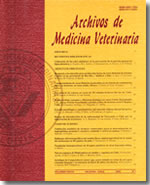Physiometabolic profile of Belgian Malinois Shepherd and Dutch Shepherd dogs in response to a training session for French Ring
Main Article Content
Abstract
This study evaluated the physiometabolic response to a training session for French Ring in two high performance breeds of dogs to. Twenty male and female Belgian Malinois Shepherd and Dutch Shepherd dogs were used. Animals aged 10 to 24 months and weighing between 30 and 35 kg (66-77 lbs) performed a French Ring routine for 20 minutes. Blood samples were taken at three moments: prior to training, immediately after exercise, and then 1 h later. All samples were drawn from the cephalic vein. Lactate, pH, calcium, potassium and blood gas (pCO2 and pO2) levels were determined using a critical blood variables analyzer. Heart rate and body temperature were also recorded. In both breeds, temperature, pO2, pCO2, lactate and pH levels increased (P < 0.05) immediately after the training period, but decreased 1 h after exercise (P < 0.05). The Belgian Malinois Shepherd dogs showed an increase (P < 0.05) in cardiac frequency in the post-training period, with a later recovery (P < 0.05) that tended towards initial values. The Dutch Shepherd breed displayed a decrease (P < 0.05) in calcium levels after training that remained without change during recovery. In conclusion, these results provide biochemical and physiological data that will make possible to evaluate and estimate the potential for competitive performance of these breeds, improving the selection of these two dog breeds.

